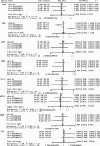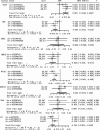Repurposing lipid-lowering drugs on asthma and lung function: evidence from a genetic association analysis
- PMID: 38961500
- PMCID: PMC11223406
- DOI: 10.1186/s12967-024-05359-5
Repurposing lipid-lowering drugs on asthma and lung function: evidence from a genetic association analysis
Abstract
Objective: To explore the correlation between asthma risk and genetic variants affecting the expression or function of lipid-lowering drug targets.
Methods: We conducted Mendelian randomization (MR) analyses using variants in several genes associated with lipid-lowering medication targets: HMGCR (statin target), PCSK9 (alirocumab target), NPC1L1 (ezetimibe target), APOB (mipomersen target), ANGPTL3 (evinacumab target), PPARA (fenofibrate target), and APOC3 (volanesorsen target), as well as LDLR and LPL. Our objective was to investigate the relationship between lipid-lowering drugs and asthma through MR. Finally, we assessed the efficacy and stability of the MR analysis using the MR Egger and inverse variance weighted (IVW) methods.
Results: The elevated triglyceride (TG) levels associated with the APOC3, and LPL targets were found to increase asthma risk. Conversely, higher LDL-C levels driven by LDLR were found to decrease asthma risk. Additionally, LDL-C levels (driven by APOB, NPC1L1 and HMGCR targets) and TG levels (driven by the LPL target) were associated with improved lung function (FEV1/FVC). LDL-C levels driven by PCSK9 were associated with decreased lung function (FEV1/FVC).
Conclusion: In conclusion, our findings suggest a likely causal relationship between asthma and lipid-lowering drugs. Moreover, there is compelling evidence indicating that lipid-lowering therapies could play a crucial role in the future management of asthma.
Keywords: Asthma; Casual association; Lipids; Lowering-lipid therapy; Mendelian randomization.
© 2024. The Author(s).
Conflict of interest statement
Not applicable.
Figures




Similar articles
-
Exploring the causal effect between lipid-modifying drugs and idiopathic pulmonary fibrosis: a drug-target Mendelian randomization study.Lipids Health Dis. 2024 Aug 1;23(1):237. doi: 10.1186/s12944-024-02218-6. Lipids Health Dis. 2024. PMID: 39090671 Free PMC article.
-
Genetic correlation between genes targeted by lipid-lowering drugs and venous thromboembolism: A drug-target Mendelian randomization study.Medicine (Baltimore). 2024 Dec 20;103(51):e40770. doi: 10.1097/MD.0000000000040770. Medicine (Baltimore). 2024. PMID: 39705479 Free PMC article.
-
Evaluating the Cardiometabolic Efficacy and Safety of Lipoprotein Lipase Pathway Targets in Combination With Approved Lipid-Lowering Targets: A Drug Target Mendelian Randomization Study.Circ Genom Precis Med. 2025 Apr;18(2):e004933. doi: 10.1161/CIRCGEN.124.004933. Epub 2025 Mar 7. Circ Genom Precis Med. 2025. PMID: 40052268 Free PMC article.
-
Established and Emerging Lipid-Lowering Drugs for Primary and Secondary Cardiovascular Prevention.Am J Cardiovasc Drugs. 2023 Sep;23(5):477-495. doi: 10.1007/s40256-023-00594-5. Epub 2023 Jul 24. Am J Cardiovasc Drugs. 2023. PMID: 37486464 Free PMC article. Review.
-
ANGPTL3 and Apolipoprotein C-III as Novel Lipid-Lowering Targets.Curr Atheroscler Rep. 2021 Mar 10;23(5):20. doi: 10.1007/s11883-021-00914-7. Curr Atheroscler Rep. 2021. PMID: 33694000 Review.
Cited by
-
Low-Density Lipoprotein Cholesterol as a Protective Factor in COPD and Implications for Statin Therapy: A Multi-Omics Genetic Epidemiology Study.Int J Chron Obstruct Pulmon Dis. 2025 Jul 14;20:2409-2422. doi: 10.2147/COPD.S516906. eCollection 2025. Int J Chron Obstruct Pulmon Dis. 2025. PMID: 40688239 Free PMC article.
-
Lipid-lowering drug targets associated with risk of respiratory disease: a Mendelian randomization study.BMC Pulm Med. 2025 Feb 11;25(1):71. doi: 10.1186/s12890-025-03527-x. BMC Pulm Med. 2025. PMID: 39934773 Free PMC article.
References
-
- Mims JW. Asthma: definitions and pathophysiology. Int Forum Allergy Rhinol. 2015;5(Suppl 1):S2–6. - PubMed
MeSH terms
Substances
Grants and funding
LinkOut - more resources
Full Text Sources
Medical
Miscellaneous

